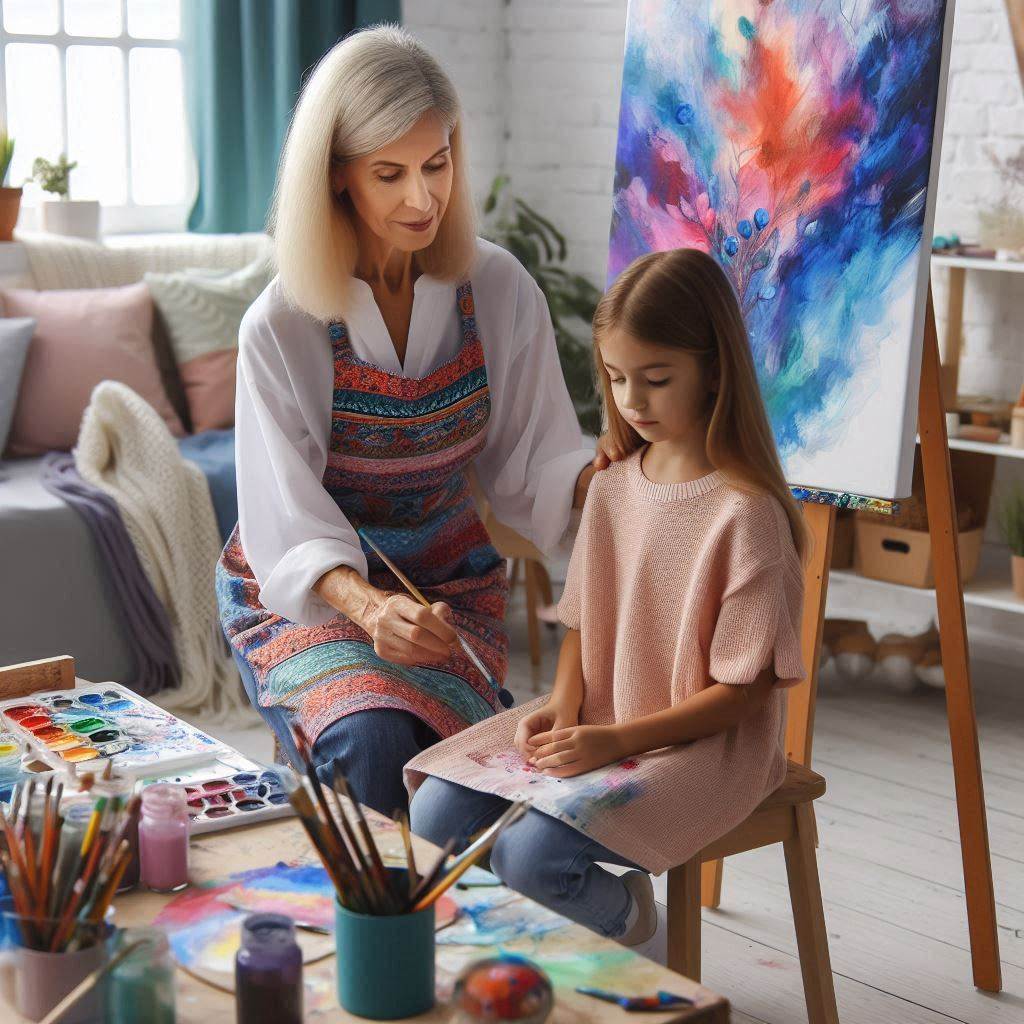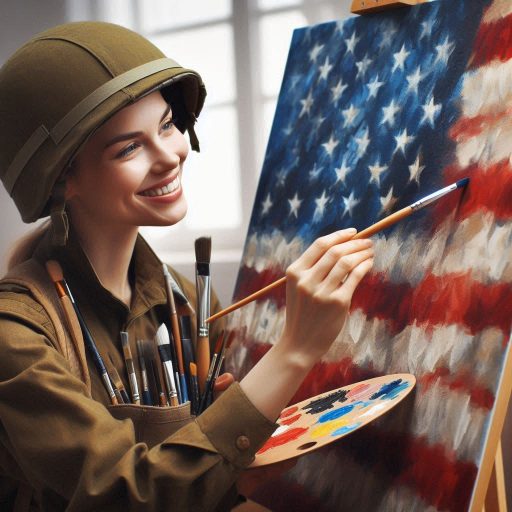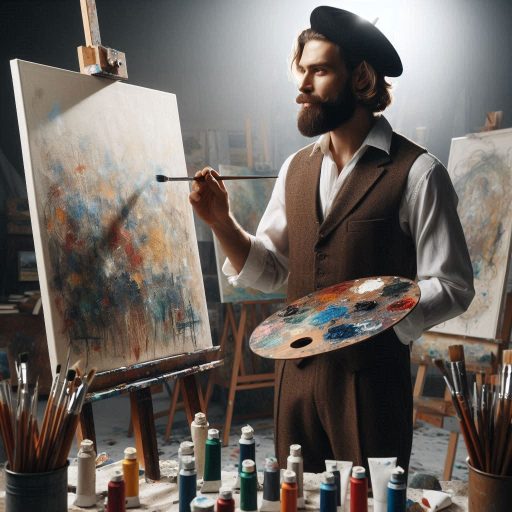Introduction
Art therapy involves using art as a form of therapy, while art education focuses on teaching artistic skills.
Understanding the Differences
Art therapy is used in a therapeutic setting to help individuals express themselves creatively, while art education focuses on teaching techniques and art history.
Art therapy is more about the process of creating art and exploring emotions, while art education is about learning specific skills and concepts.
Importance of Knowing the Distinctions
Understanding the differences between art therapy and art education is crucial for professionals in both fields. It allows for the appropriate application of each in different contexts.
Art therapy can be beneficial for individuals dealing with mental health issues, while art education can enhance artistic skills and creativity.
By knowing the distinctions, practitioners can tailor their approach to better meet the needs of their clients or students.
Overall, both art therapy and art education play important roles in enhancing creativity, self-expression, and overall well-being.
Definition and Purpose of Art Therapy
Definition of Art Therapy and Its Main Purpose
Art therapy combines psychology and artistic expression to support emotional healing.
It involves trained professionals using art materials to facilitate therapeutic processes.
The primary aim is to help individuals explore feelings, reduce anxiety, and improve mental health.
In art therapy, the focus is on the individual’s emotional and psychological needs.
Clients may struggle with trauma, depression, anxiety, or other mental health issues.
Through creative expression, they find new ways to communicate and understand their experiences.
Art therapists create a safe environment for self-exploration.
They encourage clients to express themselves freely without judgment.
This non-verbal communication can be particularly beneficial for those who struggle to articulate their emotions verbally.
How Art Therapy Uses the Creative Process to Improve Mental Health
Art therapy employs the creative process as a healing tool.
Clients engage in various artistic activities, such as painting, drawing, or sculpting.
These activities allow them to express thoughts and feelings that might be difficult to verbalize.
The process of creating art serves as a form of self-discovery.
As clients engage with materials, they often uncover insights about themselves.
This exploration can lead to increased self-awareness and emotional regulation.
Art therapists guide clients through the creative process.
They provide support and techniques that help individuals navigate their emotions.
By reflecting on the artwork, clients can gain clarity about their thoughts and feelings.
Research shows that engaging in creative activities positively impacts mental health.
Art-making can reduce stress, enhance mood, and promote relaxation.
These benefits extend beyond the therapy session, improving clients‘ overall well-being.
In art therapy, the final product is less important than the process.
The focus lies on the emotional journey rather than artistic skill.
Clients are encouraged to experiment without the pressure of achieving perfection.
This emphasis on the creative process sets art therapy apart from traditional art education.
While art education aims to teach techniques and skills, art therapy prioritizes emotional expression.
The two fields, while related, serve different purposes and audiences.
Basically, art therapy provides a unique approach to mental health through creative expression.
By focusing on emotional healing, it helps individuals process their experiences.
Understanding these key differences between art therapy and art education highlights the distinct value each field offers.
Art therapy stands as a powerful method for fostering well-being and self-exploration through art.
Read: How to Create Memorable Characters: Pro Tips
Education and Training
Requirements for Becoming an Art Therapist
To become an art therapist, individuals must meet specific educational requirements.
Typically, aspiring art therapists earn a master‘s degree in art therapy or a related field.
This program combines coursework in psychology, art, and therapeutic techniques.
Students learn to use art as a tool for emotional healing and self-expression.
In addition to formal education, art therapists must complete supervised clinical training.
This hands-on experience is crucial for developing practical skills in therapeutic settings.
Many programs require students to complete internships in hospitals, schools, or private practices.
These experiences provide invaluable opportunities to apply theoretical knowledge in real-world situations.
After completing their education and training, art therapists must obtain licensure.
Each state has its own requirements for licensure, often involving passing an examination.
Art therapists may also pursue certification from organizations like the Art Therapy Credentials Board (ATCB).
This credential enhances their professional credibility and demonstrates a commitment to best practices.
Comparison with the Education and Training Needed for Art Educators
In contrast, becoming an art educator requires a different educational pathway.
Most art educators hold a bachelor‘s degree in art education or a related field.
This degree focuses on teaching techniques, curriculum development, and art history.
Students learn how to inspire creativity in their students and develop their artistic skills.
While art education programs may include some psychology courses, they do not focus on therapy techniques.
Instead, art educators learn how to teach art effectively in classrooms or community settings.
This training prepares them to design lesson plans, assess student progress, and foster artistic development.
Art educators must also obtain teaching certification, which varies by state.
This certification typically requires passing exams and completing a student teaching experience.
Art educators learn classroom management and instructional strategies to engage diverse learners.
Unlike art therapists, art educators do not require extensive clinical training.
Their primary goal is to teach artistic skills and promote creative expression.
While they may address students’ emotional needs, their focus remains on education rather than therapy.
Read: Ceramic Art Exhibitions to Visit in 2024
Setting and Environment
When it comes to the setting and environment in which art therapy and art education take place, there are key differences that shape the experiences of participants.
Let’s delve into how these settings vary and impact the practices of art therapy and art education:
Art Therapy Setting
- Art therapy is often practiced in clinical settings such as hospitals, mental health clinics, rehabilitation centers, and private practices.
- These environments are designed to provide a safe and therapeutic space for individuals to explore their emotions and express themselves creatively.
- Art therapists work closely with clients to address emotional issues, trauma, stress, and mental health concerns through various art modalities.
- The focus is on the process of creating art rather than the final product, as the act of art-making is seen as a form of self-expression and healing.
- Art therapy sessions are typically one-on-one or in small groups to ensure individualized attention and support for clients.
Art Education Setting
- In contrast, art education usually takes place in a more traditional classroom setting within schools, community centers, and educational institutions.
- The primary goal of art education is to teach artistic skills, techniques, art history, and appreciation for the arts to students of all ages.
- Art educators focus on developing students’ creativity, critical thinking, and visual literacy through structured lesson plans and projects.
- Students are often evaluated based on their ability to follow instructions, demonstrate technical proficiency, and produce visually appealing artwork.
- Class sizes in art education settings tend to be larger, making it challenging for educators to provide personalized attention to each student.
Overall, the setting and environment play a significant role in shaping the practices of art therapy and art education.
While art therapy focuses on emotional healing and self-expression in clinical settings, art education emphasizes skill development and artistic growth in a classroom setting.
Understanding these differences is crucial for anyone interested in pursuing a career in either field.
Read: Character Design Trends: What‘s Hot in 2024?

Clientele and Goals
Target Audience for Art Therapy
Art therapy primarily targets individuals facing mental health issues.
This includes people dealing with anxiety, depression, or stress-related disorders.
Trauma survivors also benefit significantly from art therapy.
Many use it to process their experiences and emotions in a safe environment.
Additionally, individuals with developmental disabilities or cognitive impairments often find art therapy beneficial.
This therapeutic approach accommodates various needs, allowing for personal expression and emotional exploration.
Art therapists work closely with clients to create a supportive space.
They encourage participants to use art as a means of expression.
This engagement can be particularly helpful for those who struggle to communicate verbally.
By focusing on the creative process, art therapy allows individuals to explore their emotions and gain insight into their experiences.
Goals of Art Therapy Sessions vs. Goals of Art Education Classes
The goals of art therapy sessions differ significantly from those of art education classes.
In art therapy, the primary aim is emotional healing and personal growth.
Therapists guide clients to explore their feelings and address psychological challenges.
They focus on self-discovery, expression, and coping strategies.
Each session prioritizes individual experiences, fostering a safe environment for emotional exploration.
In contrast, art education classes aim to teach specific skills and techniques.
These classes focus on artistic development, including drawing, painting, and sculpture.
Educators strive to cultivate creativity, critical thinking, and technical proficiency.
They encourage students to explore different mediums and styles, promoting artistic expression and personal voice.
While art therapy emphasizes emotional healing, art education promotes skill-building.
Participants in art education may pursue art as a career or hobby.
They engage in projects and critiques, honing their artistic abilities and understanding of art history.
This academic approach nurtures creativity but does not focus on emotional challenges.
In review, art therapy and art education serve different purposes and audiences.
Art therapy supports individuals with mental health issues, focusing on healing and self-exploration.
Its goals center on emotional expression and personal growth.
Conversely, art education targets skill development and artistic proficiency.
It encourages creativity and exploration within structured learning.
By understanding these differences, individuals can choose the appropriate path for their personal and artistic development.
Both fields contribute to the enrichment of lives, offering unique benefits for participants.
Read: How to Price Your Ceramic Artwork
Techniques in Art Therapy
Different Therapeutic Techniques Used in Art Therapy
Art therapy focuses on healing and personal growth through creative expression.
Therapists utilize various techniques, such as drawing, painting, and sculpting.
Each technique serves a specific purpose in addressing emotional and psychological issues.
Drawing is a fundamental technique in art therapy.
It allows clients to express feelings that may be difficult to articulate.
Therapists encourage individuals to explore their emotions through line and color.
This process can reveal underlying issues and promote self-discovery.
Painting, another vital technique, encourages emotional exploration through color and texture.
Clients may use watercolors, acrylics, or oil paints to convey feelings.
The act of painting can be cathartic, helping clients release pent-up emotions.
Therapists guide clients in reflecting on their artwork, facilitating discussion and insight.
Sculpting also plays a significant role in art therapy.
This three-dimensional medium allows clients to work with their hands and create tangible representations of their feelings.
Sculpting can be particularly beneficial for those who struggle with verbal expression.
The physicality of working with materials fosters a deeper connection to emotions.
Overall, art therapy employs these techniques as therapeutic tools.
Each artistic expression serves to promote healing, self-awareness, and emotional growth.
Transform Your Career Today
Unlock a personalized career strategy that drives real results. Get tailored advice and a roadmap designed just for you.
Start NowContrasting Teaching Approaches Used in Art Education
In contrast, art education focuses on skill development and artistic techniques.
Educators emphasize the importance of learning various art forms and mediums.
They encourage students to explore their creativity while building technical skills.
Art educators often use structured lesson plans.
These plans introduce specific techniques and concepts, such as color theory, composition, and perspective.
Students receive guidance on how to use different materials effectively.
This structured approach helps them develop a solid foundation in art.
Critique and feedback play a significant role in art education.
Educators provide constructive criticism to help students improve their work.
This process encourages self-reflection and growth as artists.
Students learn to appreciate different perspectives and develop their unique styles.
Additionally, art education often includes historical context.
Teachers introduce students to influential artists and movements.
This knowledge enriches students’ understanding of art and its significance.
It also inspires them to incorporate diverse influences into their work.
In essence, art therapy and art education have distinct objectives and methods.
Art therapy employs therapeutic techniques like drawing, painting, and sculpting to promote emotional healing.
In contrast, art education focuses on skill development through structured teaching approaches.
Understanding these differences highlights the unique contributions each field makes to the world of art and mental health.
Assessment and Evaluation
How Progress is Measured in Art Therapy Sessions
In art therapy, progress is measured through personal expression and emotional growth.
Therapists assess changes in a client’s artwork and emotional responses.
They focus on the therapeutic process rather than specific artistic skills.
This approach emphasizes self-discovery, healing, and emotional well-being.
Therapists often use tools like journals and verbal reflections to track progress.
Clients may share their feelings about their artwork during sessions.
This dialogue helps therapists understand clients’ emotional journeys.
It provides insight into their thoughts and experiences, fostering a deeper connection.
Art therapy also utilizes qualitative assessments.
Therapists observe behavioral changes, coping strategies, and relationship dynamics.
These observations help gauge the effectiveness of therapeutic interventions.
For example, a client‘s increased willingness to share personal experiences indicates progress.
Additionally, art therapists may set specific therapeutic goals with clients.
These goals can include expressing emotions or exploring trauma.
Progress is measured by how well clients achieve these goals over time.
This personalized approach ensures that therapy aligns with each client’s unique needs.
Contrasting Methods of Evaluating Students in Art Education
In contrast, art education evaluates students based on skill development and artistic knowledge.
Teachers focus on assessing technical abilities, creativity, and understanding of art concepts.
They use structured assignments, projects, and portfolios to evaluate students‘ progress.
Grading in art education often incorporates specific criteria.
These criteria might include originality, effort, and adherence to project guidelines.
Teachers provide feedback on students’ artistic techniques and conceptual development.
This structured assessment fosters skill acquisition and artistic growth.
Peer reviews and critiques are common methods of evaluation in art education.
Students present their work to classmates, encouraging constructive feedback.
This process enhances critical thinking and encourages artistic dialogue.
Students learn to appreciate diverse perspectives while honing their own skills.
Standardized tests and rubrics may also play a role in evaluating students.
Educators can measure progress against specific learning objectives and benchmarks.
This systematic approach helps ensure students meet educational standards and goals.
Ethical Considerations
Ethical Guidelines and Boundaries in Art Therapy Practice
Art therapy focuses on healing through creative expression.
Therapists work with clients to explore emotions, reduce anxiety, and enhance mental well-being.
To protect clients, art therapists must adhere to strict ethical guidelines.
These guidelines establish the boundaries of the therapeutic relationship.
Confidentiality is a cornerstone of art therapy ethics.
Therapists must safeguard clients’ privacy and ensure that personal information remains confidential.
This principle allows clients to express themselves freely without fear of judgment or exposure.
In addition, art therapists must maintain professional boundaries.
They should avoid dual relationships that could impair objectivity or cause harm.
Maintaining a clear distinction between the therapist’s role and personal relationships ensures clients feel safe and supported.
Art therapists also prioritize informed consent.
Clients must understand the purpose of therapy, the techniques used, and any potential risks involved.
Providing clear information enables clients to make informed decisions about their participation.
How Ethics in Art Therapy Differ from Ethics in Art Education
While both art therapy and art education value ethics, their focuses differ significantly.
Art education emphasizes skill development, creativity, and artistic expression.
Teachers guide students through learning techniques, art history, and the appreciation of art.
In art education, the ethical guidelines primarily focus on academic integrity and fostering a positive learning environment.
Teachers strive to create a space where students feel safe to explore their creativity.
They encourage exploration without the same level of confidentiality required in art therapy.
Another key difference lies in the nature of the relationship.
Art educators do not engage in therapeutic relationships with their students.
Their primary goal is to teach and inspire rather than provide psychological support.
This distinction shifts the ethical responsibilities, as art educators are not required to maintain confidentiality in the same manner as art therapists.
Art educators often encourage collaboration and peer feedback.
They promote a community where students learn from one another, which is less common in art therapy.
The emphasis on collaboration can lead to a more open exchange of ideas in art education.
In summary, ethical guidelines and boundaries play essential roles in both art therapy and art education.
Art therapy prioritizes confidentiality, informed consent, and professional boundaries.
In contrast, art education focuses on academic integrity and fostering creativity in a supportive environment.
Understanding these differences ensures that both art therapists and educators uphold their ethical responsibilities while serving their respective communities.
Explore Further: Top Companies Hiring Automotive Designers
Conclusion
Art therapy and art education serve different purposes and have unique approaches to using art for personal growth and development.
Understanding these key differences is crucial for students, practitioners, and potential clients.
Firstly, art therapy focuses on the therapeutic process of creating art to improve mental health and well-being, while art education emphasizes skill development and art history.
Art therapists are trained mental health professionals who use art as a tool for self-expression and healing, whereas art educators are trained to teach artistic techniques and theory.
Art therapy sessions are typically conducted one-on-one or in small groups with a focus on the individual’s emotional and psychological needs.
While art education often takes place in a classroom setting with a broader focus on teaching art skills to a group of students.
Overall, the key differences between art therapy and art education lie in their goals, methods, and target populations.
Art therapy is more focused on personal growth and healing, while art education is geared towards developing artistic skills and knowledge.
By understanding these distinctions, students can choose the path that aligns with their goals, practitioners can provide more effective treatment, and potential clients can make informed decisions about their artistic journey.
[E-Books for Sale]
The Big Book of 500 High-Paying Jobs in America: Unlock Your Earning Potential
$19.99 • 500 High-Paying Jobs • 330 pages
Explore 500 high-paying jobs in America and learn how to boost your career, earn more, and achieve success!
See All 500 High-Paying Jobs of this E-Book
1001 Professions Without a Degree: High-Paying American Jobs You Can Start Now
$19.99 • 1001 Professions Without a Degree • 174 pages
Discover 1001 high-paying jobs without a degree! Unlock career tips, skills, and success strategies for just $19.99!




